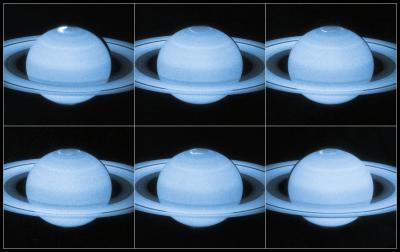Images of Saturn's auroras as the planet's magnetic field is battered by charged particles from the Sun have led a team to claim decisive evidence for the hypothesis that Saturn's auroral displays are often caused by the dramatic collapse of its "magnetic tail".
Just like comets, planets such as Saturn and the Earth have a "tail" – known as the magnetotail – that is made up of electrified gas from the Sun and flows out in the planet's wake.
When a particularly strong burst of particles from the Sun hits Saturn, it can cause the magnetotail to collapse, with the ensuing disturbance of the planet's magnetic field resulting in spectacular auroral displays. A very similar process happens here on Earth.
Recent ultraviolet images, taken by Hubble's super-sensitive Advanced Camera for Surveys, capture moments when Saturn's magnetic field is affected by bursts of particles streaming out from the Sun.

Images of Saturn's northern UV auroras were obtained by Nichols and coworkers using the Advanced Camera for Surveys onboard the Hubble Space Telescope. The auroras are clearly visible near the north pole and exhibit changes in shape over the course of the observing interval. Credit: NASA, ESA, Jonathan Nichols (University of Leicester).
Due to the composition of Saturn's atmosphere, its auroras shine brightly in the ultraviolet range of the electromagnetic spectrum. This observation campaign using Hubble meant the astronomers were able to gather an unprecedented record of the planet's auroral activity.
The team caught Saturn during a very dynamic light show. Some of the bursts of light seen shooting around Saturn's polar regions traveled at over three times faster than the speed of the gas giant's rotation.
Between Hubble and NASA's Cassini spacecraft, astronomers managed to capture a 360-degree view of the planet's aurora at both the north and south poles. Cassini also used optical imaging to delve into the rainbow of colours seen in Saturn's light shows.
On Earth, observers of auroras see green curtains of light with flaming scarlet tops. Cassini's imaging cameras reveal similar auroral veils on Saturn, which are red at the bottom and violet at the top.
"These images are spectacular and dynamic, because the auroras are jumping around so quickly," Dr Jonathan Nichols, of the University of Leicester's Department of Physics and Astronomy, who led the Hubble observations, said.
"The key difference about this work is that it is the first time the Hubble has been able to see the northern auroras so clearly.
"The particular pattern of auroras that we saw relates to the collapsing of the magnetotail," he added. "We have always suspected this was what also happens on Saturn. This evidence really strengthens the argument."
"Our observations show a burst of auroras that are moving very, very quickly across the polar region of the planet. We can see that the magnetotail is undergoing huge turmoil and reconfiguration, caused by buffering from solar wind," Nichols said. "It's the smoking gun that shows us that the tail is collapsing."






Comments